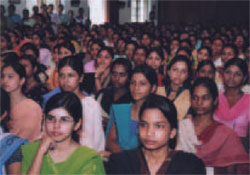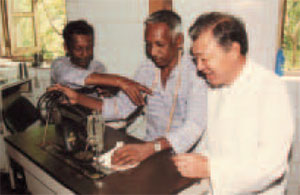|
AMBASSADOR'S JOURNAL
India's Progress
Meetings in Bihar and Goa confirm the headway that India is making in its efforts to eliminate leprosy and tackle discrimination but also the challenges that still lie ahead.
BIHAR (AUGUST 26-29)
At the end of August I visited Bihar in northeast India. It was my second visit to this populous state, one of several where much work remains to be done if India is to achieve the goal of elimination by the end of 2005.
I used to be pessimistic about Bihar's prospects. When I first visited in December 2002, the prevalence rate was 11 per 10,000 population. This time, according to Bihar's health ministry, it was down to 4.5/10,000. I am encouraged to see that the efforts of those who have been working hard for leprosy elimination in Bihar now appear to be bearing fruit.
In total, I spent three days in Patna, Bihar's capital, and one day in Gaya. In Patna, I attended two meetings. The first was a workshop to discuss the role of medical professionals, the media and NGOs in leprosy elimination. The second was on how to involve non-leprosy organizations.
The workshop, which was organized by Dr. S.D. Gokhale, Chairman, International Leprosy Union, and chaired by Dr. P.K. Gopal, President, IDEA India, also focused on the role of cured persons. In particular, it looked at the part they can play in educational campaigns to neutralize discrimination and so make it easier for people to come forward for treatment.
We must do everything to enable all cured persons to be accepted by society.
Speaking out: people recovered from leprosy address the Bihar workshop |
On the opening day, about 30 recovered persons each gave a self introduction. They included an MBA student, a housewife, a construction worker, a stationer, a shopkeeper, a milkman, a barber, a bicycle repair man and a computer technician. They all appeared to be leading normal lives. But encouraging as this was, such people are the exception, not the rule, and I believe we must do everything possible to enable all cured persons to be accepted by society.
The second meeting I took part in was on the role of social organizations and was attended by about 60 representatives of companies, banks, industry organizations and other groups. Representing the Bihar government was Health Commissioner Dr. A.K. Choudhary; attending from WHO were Dr. S.J. Habayeb and Dr. Derek Lobo, and from the government of India, Dr. G.P.S. Dhillon, DDG (Leprosy).
Dr. Choudhary said that while Bihar is making progress in reducing the number of patients, work still needs to be done to restore the dignity of cured persons. Dr. Lobo said it was important to move beyond the current situation where cured persons tend to find work only within the leprosy community; they must be given support in finding outside work.
I used the opportunity to appeal for the support of all sections of society, stressing the three messages that leprosy is curable, treatment is free, and social discrimination has no place. I emphasized that if every Indian was to have a proper understanding of leprosy, it was vitally important to start a huge social movement.
While in Patna, I gave a speech at Patna Women's College. I told my audience of 500 students that leprosy wasn't just a medical disease, but was a social problem with a long history of human discriminating against fellow human. Each student, I said, should consider leprosy elimination and the restoration of the human rights of those affected by the disease as her problem. I urged them to put Bihar at the head of the movement to eliminate leprosy from India.
For the second half of my stay I visited Patna District and Gaya District. In both, the PR has dropped to 4-5/10,000 but elimination activities are still needed. First I visited the Masaurhi primary health center, which serves a population of 200,000. Under it are two more health centers and 26 sub-centers. Health workers and community health workers (anganwadi workers) who discover new patients refer them to the primary health center. Each sub-center sees about 10-15 new patients a month. Thanks to early diagnosis and prompt commencement of treatment, there are almost no cases of deformity.
Next I went to Gaya to visit the regional hospital. Here I met the district magistrate, the head of the hospital and about 30 front-line health personnel. I thanked them for their efforts and promised to come and celebrate their success when elimination was achieved.
I also visited Bodh Gaya primary health center. There are 21 sub-centers, and a total of 95 leprosy patients registered. Here, too, I was told there were no cases of deformity.
I concluded my stay in Bihar by calling on Chief Minister Rabri Devi, and her husband Laloo Prasad, the former chief minister and now Union railways minister. Both showed keen commitment toward elimination and promised me their continued support.

Patna Women's College: students learn what they can do for elimination |
GOA (SEPTEMBER 29-OCTOBER 2)
At the end of September I visited the Indian state of Goa to attend a two-day India Health Secretaries Meeting for Leprosy Elimination sponsored by the World Health Organization. The conference discussed strategies to achieve elimination by the end of 2005, and was attended by officials of 11 out of 15 high endemic states.
The occasion was significant because of the senior level of the Indian government representatives attending - Shri J.V.R. Prasada Rao, Secretary (Health), Ministry of Health & Family Welfare; Dr. S.P. Agarwal, Director-General of Health Services; and Ms. Rita Teotia, Joint Secretary (Health).
With just over a year to go, it was important to have these top officials convey the government's determination to eliminate leprosy in front of the representatives of the endemic states. Further, it was an opportunity for government and state officials spend time together, affirm their common resolve and discuss concrete strategies.
I am also hopeful that state health secretaries and their representatives will have been inspired by the example of other states and gone away with a renewed sense of purpose to bring down the prevalence rate in their own states.
For my part, I said that I was prepared to travel to India as often as necessary until elimination was achieved, and stressed that I stood shoulder to shoulder with the Indian people. For the first time, I wore Indian national costume.
While in Goa, I visited two teenage boys currently being treated with MDT. One was diagnosed early because his mother had some knowledge of leprosy symptoms and had him checked when she discovered a patch. Later his cousin was also found to have leprosy.
One boy doesn't mind taking MDT but the other is reluctant because he's afraid it will make his skin turn dark. I told him this would only be temporary and encouraged him to take his MDT like his cousin. I was reminded how important it is to explain treatment and reaction to patients.
I also visited a state-run leprosarium established in 1934 by Dr. Froilano de Melo when Goa was a Portuguese colony. Set in some 60 acres amidst coconut palms, jackfruit trees and mango trees, it has plentiful greenery. At one time it had as many as 280 occupants but today has only 18 (11 women and 7 men), whose average age is between 70-80. It stopped accepting patients two years ago, and there is talk of eventually turning the complex into a hospital for HIV/AIDS or other diseases.
 Visiting the Leprosaria Central in Goa
Nowadays, many of its buildings have fallen into disrepair, but the wards in use appeared clean and well-run by the staff of seven nurses. The residents all wore uniforms and engaged in a variety of pursuits including electrical repairs, carpentry and painting. I was told they are content, but I sensed the loneliness of their isolated existence in their faces. One elderly lady has been living there since the age of 12. In beautiful Goa, it was all the more painful to encounter people long recovered from the disease but unable to return to society, and I renewed my determination to end the discrimination that permits this to happen.
Shri J.V.R. Prasada Rao, Secretary (Health), GOI
|